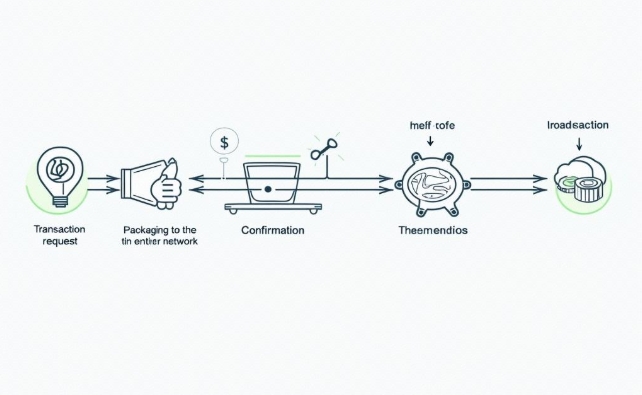In-depth Analysis of Web3 Transaction Processes: Ensuring Transparency, Security, and Efficiency
- latest articles
- 1.DApp Development & Customization: Merging Diverse Market Needs with User Experience 2.Analysis of the Core Technical System in DApp Project Development 3.How to achieve cross-chain interoperability in Web3 projects? 4.How does the tokenization of points reconstruct the e-commerce ecosystem? 5.How to Set and Track Data Metrics for a Points Mall? 6.What is DApp Development? Core Concepts and Technical Analysis 7.Inventory of commonly used Web3 development tools and usage tips 8.Development of a Distribution System Integrated with Social E-commerce 9.Six Key Steps for Businesses to Build a Points Mall System 10.What is DApp Development? A Comprehensive Guide from Concept to Implementation
- Popular Articles
- 1.Future Trends and Technology Predictions for APP Development in 2025 2.Analysis of the DeFi Ecosystem: How Developers Can Participate in Decentralized Finance Innovation 3.From Zero to One: How PI Mall Revolutionizes the Traditional E-commerce Model 4.DAPP Development | Best Practices for Professional Customization and Rapid Launch 5.Recommended by the Web3 developer community: the most noteworthy forums and resources 6.From Cloud Computing to Computing Power Leasing: Building a Flexible and Scalable Computing Resource Platform 7.How to Develop a Successful Douyin Mini Program: Technical Architecture and Best Practices 8.Shared Bike System APP: The Convenient Choice in the Era of Smart Travel 9.How to Create a Successful Dating App: From Needs Analysis to User Experience Design 10.From Design to Development: The Complete Process of Bringing an APP Idea to Life
Web3, as the next evolutionary direction of the internet, is rapidly transforming how we interact with the digital world. Unlike the traditional Web2 architecture, Web3 emphasizes decentralization, openness, and user sovereignty. Particularly with the support of blockchain technology and smart contracts, Web3 transactions have become a crucial component driving this new ecosystem. Web3 transactions are not only a manifestation of technological innovation but also reshape multiple fields such as finance, data exchange, and asset transfer, bringing unprecedented transparency, security, and efficiency.
This article will deeply analyze the process of Web3 transactions, explore how to ensure their transparency, security, and efficiency, and examine the technical principles, application scenarios, and potential challenges of Web3 transactions.
I. Basic Concepts of Web3 Transactions
The most significant difference between Web3 transactions and traditional transactions lies in their decentralized nature. In the traditional financial system, transactions are typically processed through central institutions (such as banks, payment platforms, etc.), with verification, settlement, and clearing relying on these centralized entities. In contrast, Web3 transactions, through blockchain technology and especially the application of smart contracts, enable direct transactions between parties without intermediaries, with the entire process being fully transparent and immutable.
1. Decentralized Transactions and Smart Contracts
The core driver of Web3 transactions is smart contracts, which are self-executing agreements that do not require third-party intervention. Smart contracts are self-executing code running on the blockchain, automatically performing corresponding actions when predefined conditions are met. Since the code of smart contracts is public, anyone can verify the execution process, thereby ensuring transaction transparency.
In the Web3 ecosystem, smart contracts can not only execute simple asset transfers but also handle complex decentralized finance (DeFi) operations such as lending, trading, and insurance.
2. Decentralized Exchanges (DEX)
Unlike traditional centralized exchanges (CEX), decentralized exchanges (DEX) in Web3 allow users to conduct peer-to-peer asset transactions directly, without relying on any centralized intermediaries. By combining blockchain and smart contracts, DEX ensures decentralization, public transparency, and full verifiability of transactions.

II. Transparency of Web3 Transactions
In traditional financial systems, transactions are often not public, with only the transacting parties and some regulatory agencies having access to detailed information. In contrast, Web3 transactions are inherently transparent, with all transaction records publicly available on the blockchain, accessible to anyone. Here are key aspects of Web3 transaction transparency:
1. Public Ledger of the Blockchain
The blockchain is the foundation of Web3 transactions, with its most prominent feature being an immutable public ledger. Every transaction is recorded in the blockchain's ledger, which is publicly transparent and accessible to anyone. Whether it's Bitcoin, Ethereum, or other smart contract platforms, similar mechanisms ensure the transparency of transaction records.
For example, on the Ethereum blockchain, users can query detailed information of every transaction through blockchain explorers (such as Etherscan), including the sender, receiver, amount, timestamp, etc. This public transparency allows every transaction to be traceable, greatly enhancing trust.
2. Public Code of Smart Contracts
The code of smart contracts is typically public, allowing anyone to view and verify the execution process. This means that the execution logic, fee structure, and agreed terms are transparent, enabling users to fully understand the details before executing a transaction. This transparency significantly reduces the risk of fraud and unfair practices.

3. Decentralized Governance
Many Web3 projects adopt the form of Decentralized Autonomous Organizations (DAOs) for governance, with all decision-making processes based on voting mechanisms on the blockchain. The governance process of DAOs is open and transparent, allowing any token holder to participate in decisions, and the execution of these decisions is also recorded on the blockchain, ensuring full transparency.
III. Security of Web3 Transactions
In Web3, transaction security is paramount. Due to the decentralized nature of Web3 transactions, which do not rely on any centralized third parties, security depends more on technical safeguards such as cryptography, consensus mechanisms, and the security of smart contracts. Here are the key elements of Web3 transaction security:
1. Cryptographic Safeguards
The security of Web3 transactions first relies on cryptographic technology, especially the encryption mechanism of public and private keys. In Web3, each user has a pair of public and private keys; the public key serves as an address, while the private key is used to sign transactions, ensuring their legitimacy. The security of the private key is directly related to the safety of user assets, as anyone possessing the private key can control the corresponding assets. Therefore, protecting the private key from leakage is the primary task of Web3 transaction security.
2. Vulnerability Risks in Smart Contracts
Although smart contracts provide automation and decentralization for Web3 transactions, vulnerabilities in the contracts themselves can become targets for attacks. Historically, there have been multiple attack incidents due to smart contract vulnerabilities, such as The DAO incident and the Parity wallet bug. To ensure security, smart contract code must undergo rigorous auditing and verification to ensure there are no backdoors or vulnerabilities.
3. Consensus Mechanism Safeguards
The security of Web3 transactions also relies on the blockchain's consensus mechanism. Consensus mechanisms like Bitcoin's Proof of Work (PoW) and Ethereum's Proof of Stake (PoS) ensure the security of the blockchain network, verifying and confirming every transaction through network nodes. This distributed validation mechanism makes tampering with transactions extremely difficult, ensuring the integrity and security of transaction data.
4. Security of Decentralized Exchanges
Decentralized exchanges (DEX) have high resistance to attacks due to the absence of centralized exchange servers. The security of DEX relies on the technical safeguards of smart contracts and blockchain, but it also faces challenges such as smart contract vulnerabilities and the security of liquidity pools. Therefore, DEX platforms need to continuously optimize their smart contracts and security mechanisms to prevent potential risks.
IV. Efficiency of Web3 Transactions
Although Web3 transactions excel in transparency and security, their efficiency remains a challenge, especially when handling large volumes of transactions. Improving the efficiency of Web3 transactions to ensure rapid global responsiveness is a key direction for Web3 technology development.

1. Layer 2 Solutions
To enhance the processing speed of Web3 transactions, many blockchain projects adopt Layer 2 technology. Layer 2 is an extension solution built on top of the main chain (Layer 1), improving transaction processing speed without sacrificing decentralization and security. For example, Ethereum's Rollups and the Lightning Network are typical applications of Layer 2, which process transactions collectively and only submit aggregated results to the main chain, significantly increasing throughput and transaction speed.
2. Cross-Chain Technology
In the Web3 ecosystem, different blockchains are often isolated, with transactions confined to a single blockchain. To improve the efficiency of cross-chain transactions, many projects are developing cross-chain technologies that enable asset exchange and information flow between different blockchains. Projects like Polkadot, Cosmos, and Chainlink have made significant progress in this area.
3. Distributed Storage and Computing
The efficiency of Web3 transactions also relies on distributed storage and computing technologies. Distributed storage allows transaction data to be stored dispersedly, avoiding single points of failure and data bottlenecks. Distributed computing, on the other hand, enhances the speed of transaction verification and processing, ensuring the efficient operation of Web3 transactions globally.
V. Conclusion
Web3 transactions, through technologies such as blockchain, smart contracts, and decentralized exchanges, have successfully achieved transparency, security, and efficiency. However, despite the immense potential of Web3, current technological implementations still face many challenges, such as security vulnerabilities in smart contracts, the need to improve transaction efficiency, and interoperability issues across chains. With continuous technological development and innovation, Web3 transactions are expected to achieve a more complete ecosystem in the future, driving the rise of the global decentralized economy.
For developers and participants, understanding the processes, safeguards, and potential risks of Web3 transactions will help us better utilize this emerging technology and contribute to building a more transparent, secure, and efficient digital world.
-

How to achieve cross-chain interoperability in Web3 projects?
With the continuous development of WEB3 technology, Web3 has gradually become an···
-

Inventory of commonly used Web3 development tools and usage tips
With the continuous development of blockchain technology, Web3 has become a hot ···
-

Web3 development trend prediction: analysis of future technology directions and application scenarios
With the gradual development of blockchain technology, the concept of Web3 has m···

 Blockchain
Blockchain










